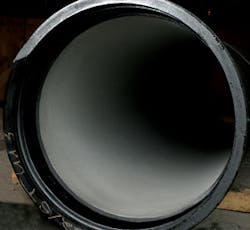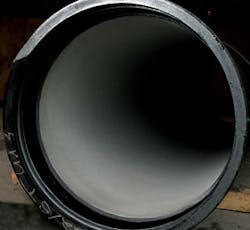By L.G. Horn
The mantra of saving energy is a growing trend. For example, homeowners can program modern thermostats to make energy consumption more efficient. The development of hybrid vehicles and electric-powered cars stems from a desire to minimize reliance on fossil fuels and their effects on the environment. And the Defense Department is dedicated to researching biofuels, solar and wind power, and other means of reducing energy use.
Reducing energy consumption has become, in short, a societal priority. This isn't simply because eliminating waste puts less strain on our natural resources and our communities -- it's also because it puts less strain on our wallets.
A little known fact is that some significant energy savings can already be found in the type of water pipes that serve our communities. Given the increased focus on energy and the need to update our aging water infrastructure, this is a good time to recognize the advantages that already exist with ductile iron pipe.
All modern pipe materials provide smooth inside surfaces, which for water pipelines are characterized by high Hazen-Williams flow coefficients -- the "C factor." The higher the C factor, the better the flow, and the better the flow, the lower the pumping costs.
But, there is another controlling factor. As it turns out, water pipeline materials are not as alike as they might seem. Since most of the pipe that distributes water to our neighborhoods is standardized on a common outside diameter, and since each pipe material has differing strengths, two pipes of the same nominal size often have different inside diameters. The stronger the pipe material, the greater the inside diameter and the less energy required to deliver a given demand for water to consumers.
Around the country, water pipes that have been in service for as long as a century or more are beginning to show their age. These old cast iron pipes have served our country well, earning an unmatched reputation for durability over several generations of use. However, our focus is turning to the future. The question facing many communities now is what kind of pipe to use going forward. There are substitutes for ductile iron pipe that might seem attractive at first, but they don't offer the same record of performance.
For example, there may be an inclination to consider a pipe material like PVC, whose main attraction might be lower initial purchase costs at times. However, when all aspects of its use are considered, this material may be the more costly substitute. Since PVC is weaker than ductile iron, pipe made from it provides a smaller inside diameter for flow, increasing pumping energy requirements and the harmful environmental emissions associated with energy consumption.
According to a recent analysis of the Huntsville, Ala., water system -- composed predominantly of iron pipe networks -- 5,530 tons of annual carbon emissions are estimated to have been avoided by pumping water through iron pipes instead of PVC. That's the equivalent of 562,392 gallons of gasoline, or the electrical consumption of nearly 700 homes.
What's more, Huntsville Utilities is estimated to have saved 3 percent in overall operational expenses annually as well -- a savings of more than $650,000 every year. This is the type of forward thinking that has helped Huntsville win numerous awards and accolades, including the Environmental Protection Agency's (EPA) Safe Drinking Water Excellence Award.
Is ductile iron's inside diameter more optimal than PVC across every major pipe size? The answer is yes. "By using iron pipe, Huntsville has undoubtedly saved tens of millions of dollars throughout its history," said Maury D. Gaston, Carson Smith and James C. Hogeland in the June 2014 issue of Journal AWWA.
Pulling from AWWA standards and manufacturers' information, as typically specified, ductile iron pipe consistently provides larger inside diameters than PVC -- and, therefore, less head loss than PVC. For example, in pipe nominally sized 6 inches, ductile iron's inside diameter is 6.28 inches versus PVC's 6.09 inches, and in 48-inch pipe, ductile iron's inside diameter is 49.63 inches versus just 46.49 inches for PVC. These small differences translate into large savings over a pipe's lifetime. From small to large, ductile iron's energy savings potential over PVC is written in the walls of the pipes themselves.
This type of energy savings simply adds to the reasons that water utilities and pipe experts are urging their communities to look well beyond simple initial costs when choosing pipe materials.
When considering pipe materials that are meant to last 100 years or more, taking into account only immediate costs can turn out to be very expensive for future generations. Pipe materials are not interchangeable and are not equal. They have very different service lives, strengths, operating costs, and maintenance issues.
Communities should base their pipe selection decisions on the above factors and on their past experiences. In addition to looking to history, they can also look to increasingly important energy savings and environmental advantages that result from the strength -- and the shape -- of ductile iron pipe.
About the Author: L. G. Horn, P.E., joined DIPRA in 1986 and currently holds the position of executive vice president of Technical Services for the Association. He is a registered professional engineer in the Commonwealth of Virginia as well as a certified corrosion specialist by NACE International. He is also a member of the American Water Works Association (AWWA), the Water Environment Federation (WEF), the American Society of Civil Engineers (ASCE), ASTM International, and NACE International.
More WaterWorld Current Issue Articles
More WaterWorld Archives Issue Articles




